Indonesian National Parks
There are more than fifty national parks in Indonesia, that encompass some of the most spectacular landscapes of the country.
Understand
Although the first nature conservation nature conservation areas in Indonesia were established during the Dutch colonial time, and nature reserves were expanded throughout the decades, the first five national parks were established in 1980. New national parks have been added regularly, with the latest addition being Mount Tambora National Park in Sumbawa in 2015. Of the 52 Indonesian national parks, 6 are listed on the UNESCO World Heritage List. 9 of the parks are largely marine.
Fees and permits
National parks
Sumatra
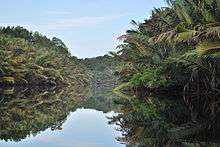
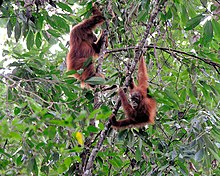
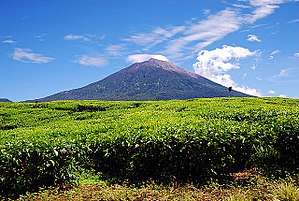
The island of Sumatra contains 11 national parks, of which 10 are on the main island itself, and 1 on the Siberut island in the Mentawai Islands. Three of the national parks of Sumatra are together listed as a UNESCO World Heritage Site as the 'Tropical Rainforest Heritage of Sumatra'.
- 🌍 Batang Gadis (North Sumatra) — in the southwestern part of North Sumatra province, the park covers a mountainous rainforest landscape between altitudes of 300 and 2,145 metres. Batang Gadis is one of the four national parks in the Barisan mountain range, and the only one that is not on the World Heritage List.
- 🌍 Berbak (Jambi) — near the east coast of Sumatra, about 100 km east of the city of Jambi. The national park consists of freshwater swamp forests and peat swamp forests. In the park there are at least 23 different species of palm tree.
- 🌍 Bukit Barisan Selatan (Lampung/Bengkulu/South Sumatra) — the southernmost national park in the Barisan mountain range, including the montane forests as well as coastal forests and mangroves. It is one of the three parks listed as World Heritage as part of the Tropical Rainforest Heritage of Sumatra. The largest remaining population of the critically endangered Sumatran elephant lives in the park.
- 🌍 Bukit Duabelas (Jambi) — literally 'the Twelve Hills', the national park consists of lowland tropical rain forests, about 100 km west of the city of Jambi. The park is inhabited by the nomadic Orang Rimba people.
- 🌍 Bukit Tigapuluh (Riau/Jambi) — literally 'the Thirty Hills', the national park is between the similar Bukit Duabelas and Tesso Nilo parks, and consists mainly of lowland tropical forest.
- 🌍 Gunung Leuser (North Sumatra/Aceh) — the northernmost national park in the Barisan mountain range, it is one of the three parks listed as World Heritage as part of the Tropical Rainforest Heritage of Sumatra. In the park is a Orangutan Rehabilitation Centre and feeding station.
- 🌍 Kerinci Seblat (West Sumatra/Jambi/Bengkulu/South Sumatra) — the largest national park of Sumatra, and the second-largest of the country, covering almost 14,000 km². It is one of the three parks listed as World Heritage as part of the Tropical Rainforest Heritage of Sumatra. In the park, the critically endangered Rafflesia arnoldii grows, the largest flower in the world. The active Mount Kerinci is the highest volcano of Indonesia (3,805 m).
- 🌍 Sembilang (South Sumatra) — south of the Berbak National Park in Jambi province, this national park also contains extensive peat swamp forests. In addition, the park has large mangrove forests. The world's largest breeding colony of milky storks can be found here.
- 🌍 Siberut (Mentawai Islands, West Sumatra) — Siberut National Park covers almost half of the island of Siberut, which is the largest of the Mentawai Islands. The park consists of rainforest, but also of swamp forests and mangroves. The park is one of the last places where the critically endangered pig-tailed langur lives.
- 🌍 Tesso Nilo (Riau) — tropical lowland forest, with critically endangered Sumatran elephants and Sumatran tigers. The national park contains an elephant conservation centre.
- 🌍 Way Kambas (Lampung) — in the far southeast of Sumatra, Way Kambas consists of swamp forest and lowland rain forest. The key Sumatran Rhino Sanctuary of the International Rhine Foundation is within the park.
Kalimantan

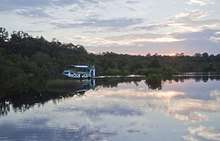
Kalimantan, the Indonesian part of the island of Borneo, contains 8 national parks. Several of Kalimantan's parks are inhabited by the critically endangered Bornean orangutan.
- 🌍 Betung Kerihun (West Kalimantan) — in the northeast of West Kalimantan province, at the border with the Malaysian state of Sarawak. Together with the Lanjak Entimau Wildlife Sanctuary sanctuary on the Malaysian site, the park has been proposed to form a World Heritage Site. The rainforest is inhabited by various Dayak tribes, and also home to the critically endangered Bornean orangutan.
- 🌍 Bukit Baka-Bukit Raya (West Kalimantan/Central Kalimantan) — mountainous national park named after the Bukit Baka (1,620 m) and Bukit Raya (2,278 m) mountains, inhabited by various Dayak tribes.
- 🌍 Gunung Palung (West Kalimantan) — along the west coast of the island, the national park has a diverse range of habitat types, ranging from mangrove and swamp forests to montane forests. Gunung Palung is one of the parks where orangutans can be seen in the wild.
- 🌍 Kayan Mentarang (North Kalimantan) — the third-largest national park of Indonesia, covering more than 13,000 km² near the border with the Malaysian states of Sarawak and Sabah. The critically endangered species Javan pangolin and helmeted hornbill can be found in the park.
- 🌍 Kutai (East Kalimantan) — about 120 km north of the provincial capital Samarinda, the national park mainly consists of lowland tropical rainforest, as well as some mangrove and swamp forests. Endangered animal species in the park include the Bornean orangutan and the long-nosed monkey.
- 🌍 Lake Sentarum (West Kalimantan) — one of the world's most biodiverse lake systems. The park covers a vast floodplain, consisting of about 20 seasonal lakes, freshwater swamp forest and peat swamp forest.
- 🌍 Sabangau (Central Kalimantan) — the Sabangau blackwater river and an extensive peat swamp forest. Although large parts of the forest area was destroyed in the 1980s and 1990s through illegal logging, the forest is still home to the world’s largest orangutan population.
- 🌍 Tanjung Puting (Central Kalimantan) — famous for its orangutan conservation. The national park consists of various (partly degraded) forest types, including peat swamp forests, mangroves, and coastal beach forests.
Java
.jpg)

Although Java is the smallest of Indonesia's five major islands, and by far the most densely populated, it also contains the most national parks. There are 12 national parks in Java (and surrounding seas), including 6 centred around volcanoes, 4 consisting mainly of hills, lowland forests, mangroves, and beaches, and 2 largely marine national parks. One of the national parks of Java is a World Heritage Site.
- 🌍 Alas Purwo (East Java) — at the southeastern tip of Java, famous for its wild Banteng cattle. The park is made up of mangroves, savanna, lowland monsoon forests, and coral-fringed beaches. The nearest city is Banyuwangi.
- 🌍 Baluran (East Java) — in the far northeast of Java. The park includes the 1,247 m high dormant Mount Baluran volcano, but consists mostly of savannah grass and acacia scrub inland and monsoon forests and mangroves.
- 🌍 Bromo-Tengger-Semeru (East Java) — national park centred around the highest mountain of Java, Mount Semeru (3,676 m), and the popular tourist attraction Mount Bromo. The national park consists of these and several more active volcanoes, gravel plains, and a sea of sand. In the valleys there are tropical rainforests and many rivers.
- 🌍 Karimunjawa (Central Java) — marine national park consisting of the 27 islands of the Karimunjawa archipelago, about 80 km north of the town of Jepara on mainland Java. The park consists of pristine coral reefs and hilly forest-covered islands with white sandy beaches.
- 🌍 Meru Betiri (East Java) — national park with a varied topography reaching from a plain coast to highlands with an altitude of almost 1,200 metres. The Sukamade turtle conservation area is part of the park.
- 🌍 Mount Ciremai (East Parahyangan, West Java) — national park centred around the Ciremai volcano (3,078 m). Because there are no other mountains nearby, Ciremai dominates its surroundings. On the eastern hillside is the village of Linggajati, which played a key role in Indonesia's War of Independence.
- 🌍 Mount Gede Pangrango (Bogor Raya, West Java) — the most-visited national park of Indonesia, because of its easy access from the Greater Jakarta area. The park consists of the Gede (2,958 m) and Pangrango (3,019 m) volcanoes.
- 🌍 Mount Halimun Salak (Bogor Raya, West Java) — mountain area national park known for its very high rainfall, and a large number of endemic bird species.
- 🌍 Mount Merapi (Central Java) — the most active volcano of the country, and one of the most dangerous volcanoes in the world.
- 🌍 Mount Merbabu (Central Java) — volcano just north of Mount Merapi, with the Ketep pass separating the two. With 57 km² this is the second-smallest national park of Indonesia.
- 🌍 Thousand Islands, Kepulauan Seribu (Greater Jakarta) — marine national park just off the coast of the national capital, in the Jakarta Bay. In reality, there are 110 islands, of which 36 are used for recreation.
- 🌍 Ujung Kulon (Banten) — the Ujung Kulon peninsula at the far western tip of Java, and several offshore islands. The park includes the natural reserve of Krakatoa and Panaitan Island, and is the last refuge of the endangered Java one-horned rhinoceros. Ujung Kulon was declared a UNESCO World Heritage Site in 1992 for containing the largest remaining lowland rain forest in Java.
Sulawesi
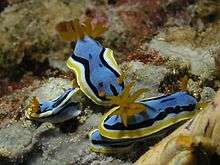
The island of Sulawesi, including surrounding seas and smaller islands, hosts 8 national parks, of which 4 are for signficant parts marine.
- 🌍 Bantimurung-Bulusaraung (South Sulawesi) — national park about 50 km north of Makassar that contains a large karst area, with dozens of pre-historic caves, and impressive waterfalls. Many butterfly species can be found in the park, and there are also various butterfly breeding centres.
- 🌍 Bogani Nani Wartabone (Gorontalo/North Sulawesi) — an important national park for wildlife conservation, about 50 km east of the city of Gorontalo. The endangered anoa (midget buffalo) lives in the park.
- 🌍 Bunaken (North Sulawesi) — marine national park off the coast of Manado with 390 species of coral as well as many fish, mollusc, reptile and marine mammal species. The park has been proposed to become a World Heritage Site.
- 🌍 Lore Lindu (Central Sulawesi) — lowland and montane forests, home to the endangered maleo bird.
- 🌍 Rawa Aopa Watumohai (Southeast Sulawesi) — the largest swamps in Sulawesi, recognised as a wetland of international importance.
- 🌍 Taka Bone Rate (Selayar Islands, South Sulawesi) — marine national park in the Flores Sea between Sulawesi and Flores, including the world's third-largest atoll.
- 🌍 Togian Islands, Kepulauan Togean (Central Sulawesi) — archipelago in the Gulf of Tomini, covered by rainforest and surrounded by coral reef formations.
- 🌍 Wakatobi (Southeast Sulawesi) — well known among divers as one of the world's best dive sites. A survey in the area identified 396 species of coral.
Nusa Tenggara
.jpg)
There are 8 national parks in the Nusa Tenggara archipelago (including Bali). One of the parks in the region is on the UNESCO World Heritage List.
- 🌍 Kelimutu (Flores, NTT) — volcano with three coloured crater lakes. With 50km² it is the smallest national park in the country.
- 🌍 Komodo (Flores, NTT) — world heritage site that is the home to the Komodo dragon, the world's largest lizard.
- 🌍 Laiwangi Wanggameti (Sumba, NTT) — national park with several types of forests, home to the endangered citron-crested cockatoo ('Sumba cockatoo').
- 🌍 Manupeu Tanah Daru (Sumba, NTT) — lowland forests on the steep slopes of Sumba's hills.
- 🌍 Mount Mutis (West Timor, NTT) — montane forest national park with at the centre the 2,427 m high Mount Mutis.
- 🌍 Mount Rinjani (Lombok, NTB) — active volcano of 3,726 m high with a huge caldera, popular for hiking.
- 🌍 Mount Tambora (Sumbawa, NTB) — the site of the most powerful volcanic explosion in modern history (1815).
- 🌍 West Bali (Bali) — varied landscape on the northwestern tip of Bali, and the offshore Menjangan island known for snorkelling and diving.
Maluku
There are 2 national parks in the Maluku archipelago.
Papua

There are 3 national parks in Papua, the Indonesian half of the island of New Guinea. One of these parks is on the UNESCO World Heritage List.
- 🌍 Lorentz (Papua) — a world heritage site and the country's largest national park (more than 25,000km²). The park ranges from marine areas of the Arafura Sea coast to the equatorial glaciers of the 4,884 m high Puncak Jaya, the highest mountain of Indonesia. Ecosystems in the national park also include mangroves, tidal and freshwater swamp forest, lowland and montane rainforest, and alpine tundra.
- 🌍 Teluk Cenderawasih, Bird of Paradise Bay (West Papua) — a rich marine ecosystem with over 150 recorded coral species.
- 🌍 Wasur (Papua) — savanna, swamp forest, monsoon forest, coastal forest, bamboo forest, and grassy plains.